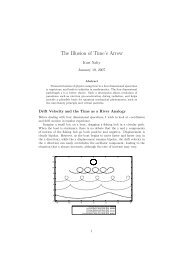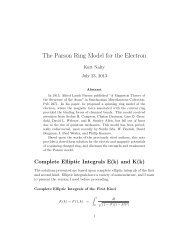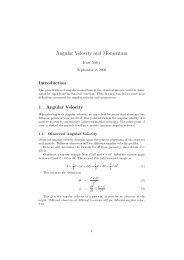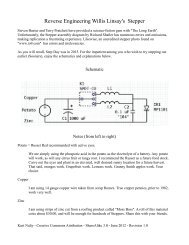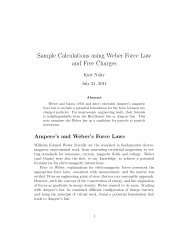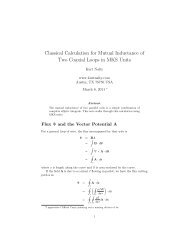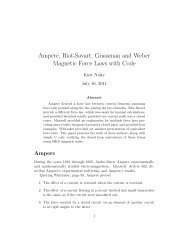Exercises with Magnetic Monopoles - Kurt Nalty
Exercises with Magnetic Monopoles - Kurt Nalty
Exercises with Magnetic Monopoles - Kurt Nalty
You also want an ePaper? Increase the reach of your titles
YUMPU automatically turns print PDFs into web optimized ePapers that Google loves.
The denominator is invariant under sign inversion for x, y and z. To see<br />
the z invariance, notice that the left and right halves of the denominator<br />
swap, and (−z − R/2) 2 = (z + R/2) 2 . The numerator is odd in x and y. By<br />
symmetry, away from the two sources, everything zeroes out.<br />
The expression has two poles, at (0, 0, ±R/2). On the z axis, away from<br />
the sources, the contribution to the integral is zero. As we hit the actual pole,<br />
the numerator goes to zero linearly while the denominator goes to zero as z 3 .<br />
I assert that the three integrals infinitesimals dx, dy and dz compensate for<br />
the cubic nature of the denominator, and that the linear numerator drives<br />
this contribution to zero.<br />
Total Angular Momentum<br />
As a reference, here is the approach found in Jackson, translated into SI<br />
units.<br />
Goldhaber and Jackson Derivation<br />
This is the approach in Jackson, Second Edition, pp. 254-256.<br />
Place the monopole charge q m at z = R. Place the electric charge q e at<br />
the origin. The fields are<br />
ρ e = r<br />
⃗E = − q ( )<br />
e<br />
∇<br />
4πɛ ⃗ 1 ⃗a r<br />
= q e<br />
r 4πɛr = q ⃗r<br />
2 e<br />
4πɛr 3<br />
⃗ρ m = ⃗r − R⃗a z<br />
⃗B = q m<br />
µ⃗ρ m<br />
4πρ 3 m<br />
6




